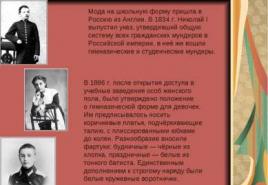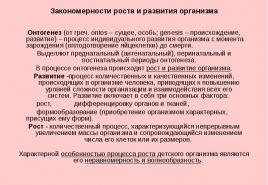School uniform presentation. Presentation "school uniform presentation for the lesson on the topic
1 slide

2 slide
The fashion for school uniforms came to Russia from England. In 1834, Nicholas I issued a decree approving the general system of all civilian uniforms in the Russian Empire, including gymnasium and student uniforms. In 1896, after the opening of access to educational institutions for women, a regulation on the gymnasium uniform for girls was approved. They were instructed to wear brown dresses that accentuated the waist, with pleated knee-length skirts. Aprons made a variety of additions: everyday aprons - black from cotton, festive - white from thin cambric. White lace collars were the only addition to the formal outfit.

3 slide
Everything changed with the coming to power of the Bolsheviks. The 1918 decree "On a single school ..." canceled the uniform for students, recognizing it as the legacy of the tsarist regime. By the end of the 1940s. uniforms returned to schools. In 1949, a unified school uniform was introduced in the USSR by decree of the Ministry of Education. Now her absence was associated with bourgeois licentiousness, and attempts to alter anything in her were severely punished

4 slide
At the same time, Soviet symbols will become an attribute of students: the pioneers have a badge and a red tie, the Octobrists and Komsomol members have a badge on their chest.

5 slide
In 1973, the uniform for boys changed again. Now the children came to lessons in blue uniforms: straight trousers and a half-woolen jacket resembling a denim one with flap pockets, five aluminum buttons, cuffs and an emblem on the sleeve: an open textbook and a rising sun. Three years later, a new uniform was introduced for high school students: it was a three-piece suit, consisting of a skirt, vest and jacket.
Slide 1
School uniform "for" and "against"
Slide 2

Purpose: to establish whether a modern student needs a uniform. Tasks: Find out when the school uniform appeared in Russia; Collect material about the history of school uniforms Get acquainted with the uniforms of other countries Find out the attitude of teachers and students to school uniforms
Slide 3

Currently in Russia there is still debate about whether students need a school uniform and what it gives: it increases discipline and academic performance or, on the contrary, deprives the child of individuality and interferes with the formation of a full-fledged personality
Slide 4

History of school uniforms in Russia The fashion for school uniforms came from England In 1834, a general system of all civilian uniforms in the Russian Empire was approved, including for secondary educational institutions. The regulation on gymnasium uniforms for girls was approved in 1896.
Slide 5

Slide 6

As part of the struggle against the legacy of the tsarist police regime, a decree was issued in 1918 that completely abolished the wearing of school uniforms. The period of "shapelessness" lasted until 1949. The school uniform becomes mandatory again only after the Great Patriotic War in the USSR. A uniform school uniform is being introduced. In 1962, the gymnasts were changed to gray woolen suits with four buttons. An important accessory was a cap with a cockade and a belt with a badge. Hairstyles were strictly regulated - under a typewriter, as in the army. And the girls' uniform remained the same.
Slide 7

Slide 8

In 1973, a new reform of the school uniform took place. A new uniform for boys appeared: it was a blue semi-woolen suit, decorated with an emblem and five aluminum buttons, cuffs and all the same two pockets with flaps on the chest. But for the girls, nothing changed again, and then the mothers-needlewomen sewed black aprons for their beauties from fine wool, and white aprons from silk and cambric, decorating with lace
Slide 9

Slide 10

Years pass, and in 1992, by the decision of the Government of Russia, with the introduction of a new Law on Education. The ban has been lifted, you can wear anything as long as your clothes are clean and tidy. The official explanation is to bring the law in line with the Convention on the Rights of the Child, which says that every child has the right to express his or her personality as he pleases. The school uniform restricts freedom of expression and has therefore been canceled. Each school decides on its own whether or not to introduce a form within its walls. If parents and management decide that children should be dressed the same, this rule is written in the school charter.
Slide 11

Uniforms Around the World The current government in England believes that uniform school uniforms play an important role in fostering school spirit: the Department of Childhood, Schools and Families strongly recommends uniform school uniforms as they can: help maintain positive behavior and discipline; to encourage class cohesion and school ideals; to ensure equality for students of all races and classes, so that everyone feels welcome; protect children from social stress; foster good relationships between different groups of students
Slide 12

Slide 13

Uniforms around the world For students in Japan, school uniforms are not only a symbol of the school, but also a symbol of modern fashion trends, which is often a decisive factor when choosing a school. In primary schools, uniforms are often not required. Where it is, boys usually wear white shirts, short white, navy blue, or black shorts and caps. For girls, a school suit may consist of a long gray skirt and a white blouse. Uniforms in middle and high school traditionally consist of military-style uniforms for boys and sailors for girls.
Slide 14

Gakuran is a male uniform in many middle and high schools in Japan. Gakuran is usually black in color, but in some schools it may be dark blue or brown. A sailor suit is a common form worn by girls in middle and high school and sometimes in elementary.
Slide 15

Uniforms around the world School uniforms in India are compulsory from lower education to high school. School uniforms for boys consist of a light shirt and dark or blue trousers. Girls in Indian schools wear a shirt and a skirt. A tie is compulsory in some schools.However, in some schools in India, it is customary for girls to wear a sari (of the same color and cut) or the so-called shalwar qameez - this is a traditional clothing for both men and women in South and Central Asia, consists of wide trousers tapering downward and a long shirt For political reasons in India, children are not prohibited from wearing articles of clothing that have religious implications. Muslim girls in India wear a chador, while Sikh boys wear a turban as part of their school uniform.
Slide 16

Slide 17

Uniforms around the world In Australia, almost all private and Catholic schools are required. In addition to everyday, there are also winter and sports options. In some schools, boys under 13-14 years old must wear shorts and only then pants
Slide 18

Uniforms of different countries of the world In Cuba, education is divided into stages, and the color of the school uniform can be used to determine which class the child is in. Also, children who are members of Cuban pioneer organizations are required to wear the red or blue scarves of the young pioneers. Colors and their combinations represent different stages of participation in the youth branch of the Communist Party
Slide 19

The main advantages of school uniforms School uniforms for girls and boys have advantages: The uniform eliminates (at least limits) the possibility of competition between students (and their parents) in clothes, significantly reduces the visual difference between students from families of different material incomes, preventing stratification by rich / poor principle. Raising inner discipline in a child Instills in the younger generation a good taste for elegant business style School uniforms, like any form, discipline, leads to cohesion, promotes the development of a sense of community, collectivism, common cause and common goals in students Helps to tune in to work Does not allow teenagers dress provocatively
Slide 20

Main disadvantages of school uniforms Uniforms can be too expensive for poor families Forms suggested on the basis of affordability may not suit the quality of families with sufficient incomes Children unwilling to wear them
Clothes for school! The question is very acuteFor both students and adults!
What you can wear and what you can't walk in
This is a problem for everyone today, friends! Object of study:
options (types) of school uniforms.
The purpose and objectives of our research:
study of the history of occurrence and change
school uniform,
the emergence of school uniforms in Russia,
School uniforms in different countries of the world,
the introduction of a school uniform in our school. Form (Latin uniform) - the same cut, color
clothing (for the military, for employees of one department, for
students). The form symbolizes the function of its bearer
and his affiliation with the organization.
School uniform is a mandatory daily uniform
clothing for students while they are at school and
at formal school events outside of school. History
emergence
school uniform School tradition of ancient Egypt.
Only noble Egyptian youths could learn: the children of Pharaoh and his
families, children of priests and high-ranking officials, or only occasionally those
who really wanted to learn. There was no school uniform as such yet. Let's move from Egypt to the ancient east - the so-called Mesopotamia
(the Tigris and Euphrates rivers).
The school was called "edubba" - "house of tablets" - and was intended before
all for the training of scribes. Special school uniforms in Mesopotamia
was not, but the children dressed like future scribes and be sure to
carried a couple of tablets and a writing stick with them. The ancient Greeks already in very early times paid great attention to
education of children. The first known school in ancient Greece was established
the famous philosopher and scientist Pythagoras.
At school, the uniform was a short tunic with artistic trim -
it is a piece of dense fabric thrown over the shoulders, which was fastened on the chest.
For centuries, this form has remained the unchanged model for
studying boys. In Rome, a public school, open to all comers, appeared in
period of the empire, or rather, in the second half of the 1st century A.D. No form
it was, only clothes for gymnastic exercises were generally accepted. But
if during classes it was found that the student's clothes are untidy, his
punished, and in case of repeated cases of sloppiness with shame
kicked out of school. In ancient India, all students had to come to classes in
certain clothes - "dhoti kurta". "Dhoti kurta" - draped
around the thighs and legs a strip of fabric, which differs in different castes by ornament,
tailoring and material. There is no evidence of the presence of a school uniform in ancient China.
However, during the reign of the Han Dynasty (206 BC - 220 AD), when
education became widespread enough, the first
mention of a school uniform. Her appearance resembled the clothes of Buddhist
monks. Middle Ages. As for Europe, a special place in the system
education was occupied by church schools, teaching mainly
clergy. The study was theological in nature with some secular
elements. The school uniform was naturally ordinary
monastic clothing, but there is no information about its obligation. A pioneering country in the introduction of school uniforms in Europe is considered
Great Britain. For the first time since ancient times, special clothing has appeared
at Christ's Hospital in 1552. Students wore navy blue tailcoats with
coats, vests, bright knee-highs and leather belts. In approximately this form, the form
survived to this day. It hasn't changed for 450 years. School
the form
in Russia The history of Russian education begins with Prince Vladimir Svyatoslavich from 988
of the year. And a hundred years later, in May 1086, the very first female
school, the founder of which is Prince Vsevolod Yaroslavovich. The first
schools were built most often at monasteries and temples. So the priests
were considered the most educated people in Russia.
There is no question of any school form, which can be seen in the images of students
below. At the beginning of the 17th century, the study of arts and sciences in schools began in a new way. Russian
the school of the 17th century was arranged like this. The students sat together, but each
the teacher gave his assignment. Learned to read and write - finished school.
In the era of Peter 1 (17th century), the first school was opened in the city of Kiev on
systematic sciences, which the king himself called a new step in
education of each person. However, in this reform, the school uniform and
has not been entered. In 1834, a law was passed establishing a general system of all
civilian uniforms. It was to them that the uniforms of the gymnasium belonged
and student.
The school uniform, intended for pupils of male gymnasiums, was sewn
on samples of military clothing:
gymnast,
cap,
trousers without piping;
in winter, an overcoat was issued, and a hood was added,
which was attached directly to the overcoat.
The form could differ in color, buttons, emblems of a particular
educational institution.
There was also a weekend or holiday uniform: dark blue or dark gray
uniform with a trimmed silver collar.
The knapsack was an invariable attribute of the gymnasium students. Gymnasium students of pre-revolutionary Russia,
late 19th century late 19th century In 1892, the uniform was canceled. It was renewed in 1896. At the same time
the development of female education began. High school students were supposed to wear
a dull brown wool dress and a black apron. And by the end of the 19th century
a formal version appeared - with a white apron and white lace
collar, sometimes with sleeves. late 19th century Before the 1917 revolution, only children from
wealthy families. And the school uniform was peculiar
an indicator of wealth and belonging to a respected class,
because only children of noblemen, intellectuals and
large industrialists.
She was an indicator of the social status of the host - if I study,
then the parents are rich. After the 1917 revolution, the history of the Soviet school begins. New
the authorities make it their top priority to increase the availability of
education for children of all walks of life
In 1918, the decree "On a single school ..." was issued, which canceled the school
shape. She was considered a bourgeois excess or a relic
of the past. The period of "formlessness" lasted until the end of the 40s.
First graders of a rural school, 20s of the twentieth century School uniform becomes mandatory again only after the Great
World War II. A unified school uniform is being introduced in the USSR. In 1949
it was decided that the girls should come to class in dark brown
woolen dresses and black aprons (white on holidays), and
boys - in gray military uniforms with a stand-up collar, five
With buttons, two slit pockets with flaps on the chest. Element
school uniform also had a belt with a buckle, which was cleaned so that
burned in the sun, and a cap with a leather visor.
At the same time, symbolism became an attribute of the student youth: among the pioneers -
red tie, Komsomol members and Octobrists have a badge on their chest.
It should be noted that, in general, the school uniform for girls of the Stalin era
resembled the school uniform of tsarist Russia. On ordinary days also
it was supposed to wear black or brown bows, and with a white apron in
holiday - white (even in such cases, white tights were welcomed) .In 1962, gymnasts were changed to gray woolen suits for
four buttons. An important accessory was a cap with a cockade and
belt with a badge. Hairstyles were strictly regulated - under a typewriter, as in
army. And the girls' uniform remained the same. Pioneer childhood of the 60s In 1973, a new reform of the school uniform took place. Boys have pants and
the jacket was replaced by a blue semi-woolen trouser suit
fabrics. The jacket was decorated with aluminum buttons, cuffs and two
pockets on the chest. On the sleeve of the jacket there was a plastic emblem with a book
and the sun.
Emblem on
boy suit
School uniform of the 80s But in 1984, it finally comes time to change the form for high school girls. They were asked to wear suits consisting of a trapeze skirt, vest and blue jacket. The skirt could be worn with either
jacket, or with a vest, or the whole suit at once. The pioneers had to
also be sure to wear a pioneer tie. Wear in high school under
uniforms for boys were supposed to be shirts, for girls all kinds of blouses. A compulsory addition to school uniform, depending on age
pupil, were Oktyabryatsky (in elementary grades), pioneer (in middle
grades) or Komsomol (in high school) badges.
Pioneer icon
October icon
Komsomol badge And in 1992 (according to the Law of the Russian Federation No. 3266-1 "On Education") the school
the uniform was canceled and the students changed their brown dresses and blue
suits for casual clothes. And if at first it made everyone happy, then with
every year there are more and more supporters of the return of the form.
There was even a tradition (or fashion) to come to the last call in
good old brown dress and white apron with tied
white bows ...
Children attended schools in loose-fitting clothes until 2013.
The motivation for the introduction of a school uniform was a scandal in one of the schools
Stavropol Territory, where teachers did not allow a student in a hijab to
classes. To iron out social, religious and other differences
Russian President Vladimir Putin suggested resurrecting school uniforms. Do I need
school
the form Arguments for the school uniform:
The school uniform, like any form, disciplines, leads to
cohesion, promotes the development of sensations in students
community, collectivism, common cause and the presence of common goals.
The form excludes (limits) the possibility of competition between
by students (and their parents) in clothes, significantly reduces
the visual difference between students from families of different
material wealth ("rich / poor").
Uniform standard for the form, if it is adopted at the state
level, allows you to ensure that the clothing of students will be
comply with sanitary and hygienic requirements and will not affect
negatively on their health.
If a single form exists, its production can be targeted
subsidize, keep prices low and remove from the poor
families part of the burden of the cost of educating children. Arguments against school uniforms:
Form is an element of egalitarian education and training.
The Convention on the Rights of the Child says that every child has
the right to express his individuality as he pleases.
School uniforms limit freedom of expression.
The requirement to wear a uniform is itself a form of violence against
personality, the requirement of strict adherence to the form can, if
desire to be arbitrarily interpreted by school staff and
be used for unjustified persecution of unwanted
students.
The uniform can be too expensive for poor families.
The form suggested based on price availability may not
to arrange the quality of the family with a sufficient level of income. School uniform
MOU "Secondary School No. 30" Now in Russia there is no single form, it has been introduced only in part of educational
institutions. Basically, these are clothes of calm shades, which are allowed
complement with things from everyday wardrobe.
In our school, MOU "Secondary School No. 30" in Syktyvkar, the REGULATIONS
on the school uniform of students in grades 1-5, in which uniform
requirements for the appearance of students.
The school uniform contributes to the creation of the business atmosphere necessary for
classes, it creates an attractive image of the school, forms and
develops a culture of business dressing among students. Requirements for casual and formal wear
1-4 grades
Casual wear
Dress clothes
For boys
jacket, black vest,
black trousers,
men's shirt, plain or
dull colors,
shoes.
black jacket,
black trousers,
men's shirt in white,
shoes.
For girls
skirt, sundress, dress, vest
dark blue,
blouse in dull colors or
monophonic,
shoes,
plain dull tights
flowers.
skirt and vest in navy blue,
blouse in white,
shoes,
plain dull tights
flowers. School uniform of students
MOU "Secondary School No. 30"
3 "p" class 5-9 grades
For boys (youths):
Vest, pullover (sweater) without drawings and without inscriptions,
trousers (black),
men's shirt (shirt) of different colors, monochromatic, dull,
shoes.
For girls (girls):
Blazer,
shoes.
10-11 grades
For boys (youths):
trousers (black),
men's shirt (shirt) of different colors, monochromatic, dull
shoes. Shirts of different colors, monochromatic, dim.
For girls (girls):
Jacket or vest, pullover (sweater) without pictures and without inscriptions,
skirt (or trousers) in black,
blouse of different colors, plain,
shoes. Students' casual and formal clothing has distinctive marks
schools: cloth backed school logo. School uniform
different countries of the world The most widespread is the school uniform in England. This form
is a reflection of the classic business style. In the most prestigious educational
institutions, a mandatory element of school clothing is a logo or
emblem. And this logo is applied to the school uniform. They make icons and
emblems. It is applied to ties and hats.
Right now in
UK no
uniform form for all
educational institutions. IN
every school
have their own
requirements. For example, in
Harrow boys wear
not only pants and
jackets, but also
straw hats Eton British College students The example of Great Britain was followed by its former colonies - India,
Australia, Singapore and others. So, Indian students attend classes
only in special uniform: boys - in navy blue trousers and white
shirts, girls - in a light blouse and a dark blue skirt. In some
In schools, girls wear saris on holidays. Singapore has not introduced a uniform uniform for all schools. In every educational
the establishment, it differs in color, but consists of classic elements of shorts and light shirts with short sleeves for boys, blouses and skirts
or a sundress - for girls. The school uniform is also worn by most Australian and New Zealand
students. In its diversity, it can be compared with the British one. But in
schools in Australia, because of the heat, more often wear shorts than trousers, and on the head
wear hats with wide or narrow brims. In another hot country - Jamaica - school uniforms are considered
mandatory. In many educational institutions, requirements are not
only to the suit, but also to the color of the socks or the heel height of the shoes. Orange,
green, purple, yellow - each school chooses its own color. In most European countries there is no uniform form, everything is limited
quite strict style.
In France, a uniform school uniform existed in the years 1927-1968. Canceled
as a result of student protests in the 1960s.
In Poland, the form has been completely canceled and its private introduction is prohibited.
separate schools.
In Belgium, only some Catholic schools have school uniforms, and
also in private schools founded by the British. Typical clothing - pants and
skirts in navy blue, white or light blue shirt and tie.
There is no uniform school uniform in Germany, although there is debate about its introduction. IN
some schools have introduced uniform school clothes that are not uniforms.
how students can participate in its development. What is typical, even during
during the Third Reich schoolchildren did not have a uniform uniform - they came to
activities in casual clothes. There is no uniform uniform in public schools in the United States and Canada, although
some schools have a dress code.
There are school uniforms in many private schools. Every school
she decides what kind of things students are allowed to wear. how
as a rule, tops that open the belly are prohibited in schools, and
low-fitting trousers. Jeans, wide leg pants with lots
pockets, T-shirts with graphics - this is what students prefer
American schools. The only form in which you will be "allowed" into
any American school - a uniform for playing American football. In Cuba, the uniform is compulsory for all students in schools and higher education institutions. School uniforms are compulsory in Turkey. Each school has its own color, but the same style. School uniforms in China are uniform. It's a baggy tracksuit. is he
usually a size or two larger than necessary. There are both girls and boys in it
look the same. In North Korea, uniform is also required. In a country where uniforms are more popular than the UK, you can
count Japan. Their shape is the standard of teenage fashion for the whole world.
For most middle and high schools in Japan, it is compulsory
school uniform. School uniforms in Japan "sailor-fuku" ("sailor
costume ") - this is a sailor suit, a skirt and bows for girls. She has already become peculiar
symbol. This is a complete clothing style. Even outside school, Japanese women wear
something that reminds them of their usual school uniform.
"Gakuran" is worn in Japan by boys - these are trousers and a dark-colored jacket with
stand-up collar. In different schools in Japan, uniform colors are different and
allocate students. Japanese schoolchildren So, the schools have come down to our time, have become what we all know them.
I wonder what the school will be like in the future?
School of the Future, as presented by French artist Marc Cote.
Knowledge is automatically pumped into students' brains, or as they say in
to the people: “The Internet is there, the mind is not necessary.” Questionnaire
pupils of 3 "p" grade
MOU "Secondary School No. 30" Anonymous questionnaire survey was conducted among students 3 "p"
class MOU "Secondary School No. 30".
All students were interviewed: 18 boys and 13 girls.
Students had to answer the following questions:
- is a compulsory school uniform required?
- if it is introduced, what should it be?
- what do they think a school uniform is for? Do I need a school uniform
15 students
16 students
need
need not
In answer to this question, the opinions of the students were divided approximately
in half. 16 students (52%) agreed with the introduction of the school uniform,
15 pupils (48%) do not agree with the mandatory introduction of the form. At the same time, most of the boys said that school uniforms are needed - 11
pupils (61%). The majority of girls (62%) do not agree with the introduction
school uniform. This is what 8 students answered.
Boys
61%
need
need not
Girls
62%
need
need not
Perhaps the choice of girls is due to the fact that they love more than boys
diversity. They don't want to wear the same clothes every day.
Most of them want to somehow stand out from the crowd, be the most
beautiful. But this can be achieved, for example, with an original hair clip for
hair that no one else has. You can also distinguish yourself from the rest with
using shoes, a backpack and more. What should be a school uniform
1 student
4 students
bright
dark
6 students
bright (colored)
4 students
16 students
I do not care
your version
Most of the pupils and female students (16 people) preferred to choose
dark color. 4 people wrote that it should be light
or bright. 6 students answered this question “I don't care”.
One boy proposed to introduce a sports-looking school uniform
(perhaps to make it easier to run during breaks). On the third question: what is a school uniform for? - it was suggested
choose multiple answers.
Almost all the boys chose 2-3 answers. Most popular answer
among them:
school uniform is the "face" of the school (11 answers),
does not allow to stand out from others, makes them equal (9 answers),
she disciplines students (8 answers).
Unlike boys, girls by far the most popular answer to the question
"What is a school uniform for?" is an
school uniforms discipline. There were 11 such answers in 13 polls
sheets,
in second place: the school uniform is the “face” of the school (5 answers).
The fact that the school uniform is a tribute to fashion, said only 1 student and 1
schoolgirl. School is a public organization, and clothing for it should be
a bit, but formal.
I believe that a school uniform is needed.
Such clothing teaches us to a certain order, discipline, gives
the opportunity to realize that they belong to a certain group.
She should be stylish, beautiful, not destroy individuality, but
also discipline, teach children that you can stand out and
you need not expensive clothes, but mental and creative abilities.
The purpose of the school uniform is to create a uniform, tidy exterior
kind of a schoolboy.
The famous fashion designer Vyacheslav Zaitsev said: “Children should
to become familiar with the fact that a suit is more than just clothes. it
means of communication. How you look depends on how you are
people around will communicate ”.
Slide 1
 Slide 2
Slide 2
 Slide 3
Slide 3
 Slide 4
Slide 4
 Slide 5
Slide 5
 Slide 6
Slide 6
 Slide 7
Slide 7
 Slide 8
Slide 8
 Slide 9
Slide 9
 Slide 10
Slide 10
 Slide 11
Slide 11
 Slide 12
Slide 12
 Slide 13
Slide 13
 Slide 14
Slide 14
The presentation on the theme "School uniform" can be downloaded absolutely free of charge on our website. Project subject: Social studies. Colorful slides and illustrations will help you engage your classmates or audience. To view the content, use the player, or if you want to download the report, click on the corresponding text under the player. The presentation contains 14 slide (s).
Presentation slides

Slide 1
Research project School uniform: pros and cons

Slide 2
School uniform: good or bad?
PURPOSE of the study: to establish whether a school uniform is necessary for a modern student. OBJECTIVES: Find out when the school uniform appeared in Russia. Collect material about the history of school uniforms. Get acquainted with the form of other countries. Find out the attitude of teachers and students to school uniforms. Find out what form the students of our school would like to wear.

Slide 3
ABOUT THE SCHOOL FORM IN SERIOUS HISTORY OF THE SCHOOL FORM IN RUSSIA
Many people ask the question: "Who invented this form?" Indeed, who? Peter I. Peter the Great was a very versatile person, and, probably, there was no area in which he did not carry out reforms. 1834 - A law was passed that approved the general system of all civilian uniforms in the empire. This system includes gymnasium and student uniforms. 1896 - the regulation on the gymnasium uniform for girls was approved. 1949 - it was decided to return to the former image: boys were dressed in military tunics with a stand-up collar, girls - in brown woolen dresses with a black apron, which almost completely copied the form of the Russian pre-revolutionary female gymnasium.

Slide 4
1973 - A new uniform for boys is introduced. Blue semi-woolen suit, embellished with emblem and aluminum buttons. The cut of the jackets resembled classic denim jackets (the so-called denim fashion was gaining momentum in the world) with shoulder straps and chest pockets with brace-shaped flaps. For high school boys, the jacket was replaced by a jacket. 1988 - Some schools were allowed, on an experimental basis, to opt out of compulsory school uniforms 1992 - abolition of school uniforms in schools of the Russian Federation.

Slide 5

Slide 6
In Japan, school uniforms have suddenly become the standard for teenage fashion. Now the girls outside the school are wearing what resembles the usual uniform of Japanese schoolgirls: "sailor-fuku", in our opinion - sailor suits, dark blue pleated mini-skirts, knee-high knee-high knee-highs and light leather shoes that match them. Boys wear "gakuran": trousers and a dark jacket with a stand-up collar. In America, school uniforms are worn by students of prestigious private schools for children of wealthy parents. In Africa, schoolgirls are banned from miniskirts. Russia, as always, has its own way. While she is looking for him, children grow up ...
Shape of different countries of the world

Slide 7
Each prestigious school in England has its own logo, reproduced on students' neckties. So shirts and ties, blazers and hats are the standard set for young Britons. In Australia, children go to classes in jeans and sweatshirts, economic classes - future financiers - wear a formal suit. In Iran, elementary school girls are allowed to wear capes not black or brown, but lighter colors, the rest wear a veil.

Slide 8
RESULTS OF STUDENTS AND TEACHERS SURVEY
From the survey "Attitudes towards school uniforms" it is clear that 83% of teachers and 67% of primary school students have a positive attitude to the introduction of student uniforms.

Slide 9

Slide 10
We consider curious the fact of our research, which concerns the color scheme of school uniforms. Primary school students are more inclined to choose strict colors: black and white. Whereas high school students and teachers represent the color background of clothes much more widely: blue, gray, yellow, green. It can be added that many of the respondents are unanimous in the opinion that the combination of colors should not be too colorful.

Slide 11

Slide 12
CONCLUSION. POSITIVE AND NEGATIVE ASPECTS OF INTRODUCING FORM IN SCHOOLS
School uniforms for girls and boys have a lot of advantages: it will help smooth out the difference in material conditions among schoolchildren; education in the child of internal discipline; instills in the younger generation a good taste for an elegant business style; the formation of a sense of community and solidarity with the class, school; makes it possible to realize yourself as a student and a member of the team; helps to tune in to work; allows you to track "strangers" in the school; does not allow teenagers to dress provocatively; avoids competition between children in clothing; saves parents money. Disadvantages of school uniforms: unwillingness of children to wear it; "Loss of individuality"; increasing financial costs for the education of the child the time and effort spent by parents in connection with the acquisition of the form; poor quality of materials and sewing of school uniforms.

Slide 13
In our research work, we learned a lot about when the school uniform appeared in Russia, what was the need for its introduction. We collected material about the history of school uniforms, got acquainted with the uniforms of other countries. We established, according to the goal set in the essay, that the modern student needs a form because it weakens social inequality that prevents students from establishing communication with each other and with teachers, and increases discipline. They found out that the greatest discrepancy in the positions of schoolchildren and teachers in the choice of the color background and style of student uniforms In the study, we established both the positive and negative aspects of introducing the student form. In further work on this topic, you can invite the children to draw (develop) a sketch of a student's uniform and hold a vote which of the models they would like to see as their uniform. Pay special attention to the opinion of high school students, for whom self-expression, free style of clothing is important.
To use the preview of presentations, create yourself a Google account (account) and log into it: https://accounts.google.com
Slide captions:
School uniform project
Project goal: To study the history of school uniforms and assess the prospects for their return, to form their own position.
Annotation of the project The first project, on which students of 3-4 grades worked, was named “School uniform. My attitude towards her. " The school uniform is a must-have daily dress for students while in school and at formal events outside of school. Now in Russia there is a lot of debate about whether students need a school uniform and what it gives: increases discipline and academic performance, or, on the contrary, deprives them of individuality. And so we decided to investigate this problem.
The purpose of our study was to determine whether there is a need to introduce a uniform form for students in school.
Research objectives: Find out when the school uniform was introduced in Russia? Study what it was like before? Conduct a survey among students in grades 3,4 "Do they like going to school in school uniforms?" Create a folder of creative works (drawings, applications, mini - compositions) on this topic.
Gathering Information Starting research on this topic, the class teacher proposed hypotheses that: School uniforms are needed because they discipline. Let's say that in the morning you don't have to think about what to wear to school. You always look neat and elegant in it.
Gathering information The object of the study was: school form. The subject of research: the need to introduce a uniform form for students in school.
The fashion for school uniforms came to Russia from England in 1834. First for boys and then for girls. After the revolution, the form was not thought of until 1949. The school uniform becomes mandatory again only after the Great Patriotic War. A unified school uniform is being introduced in the USSR. From now on, boys were required to wear military uniforms, and girls - brown woolen dresses with a black apron.
In 1973, a new uniform for boys appeared: it was a blue suit decorated with the emblem. In 1976, the girls also began to dress in new uniforms. They began to wear dark brown dresses with white cuffs and black and white aprons. School uniforms from the Soviet era are traditionally worn on the Last Bell as a symbol of farewell to school.
In the mid-1980s, the last form reform took place: blue jackets were sewn for boys and girls. The compulsory wearing of a school uniform in Russia was canceled in the spring of 1992. For many years now, Russian schoolchildren do without school uniforms, and they come to classes, who are in what will.
In modern Russia there is no uniform school uniform, as it used to be, but many schools have their own uniform. For example we 3 - 4 grade have our own form.
We conducted a survey "Do we like going to school in school uniforms?" After analyzing the results of the survey, we came to the conclusion that all students in grades 3-4 like walking in school uniform.
Our class has a business dress code.
In our class, we organized and designed an exhibition of drawings - models "School uniforms today". We wrote mini - compositions “School uniform. To be or not to be". I believe that the school uniform is the face of the student. From the research carried out, we can see that a school uniform is necessary. Conclusion: The guys look neat and they are comfortable and comfortable. No need to think in the morning what to wear to school. The school uniform teaches order and discipline.







